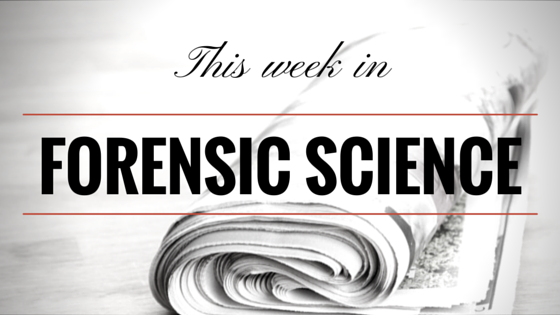No one has hours to scour the papers to keep up with the latest news, so we’ve curated the top news stories in the field of Forensic Science for this week. Here’s what you need to know to get out the door!
Who Was Detective X? (NIST – 2/9/2017)
In the gangster era of Prohibition and the Great Depression, a physicist at the National Bureau of Standards, now NIST, brought modern ideas to the then-emerging field of forensic science.
State Forensics Looking to Streamline Rape Kits in Texas (KXAN – 2/10/2017)
The Texas Forensic Science Commission wants to know how the lab’s technicians were able to examine a large number of cases if there were so many glaring problems?
How Machine Learning is Changing Crime-Solving Tactics (Phys Org – 2/10/2017)
Modern forensic DNA analyses are crucial to crime scene investigations; however the interpretation of the DNA profiles can be complex. Two researchers from the Forensics and National Security Sciences Institute (FNSSI) have turned to computer technology to assist complicated profile interpretation, specifically when it comes to samples containing DNA from multiple people.
Serial Sex Offender, 60, Who Raped a Woman in a Multi-Storey Car Park Nearly 30 Years Ago is Jailed for 21 Years After a Cold Case Review (Daily Mail – 2/10/2017)
- A man who raped a woman more than 26 years ago has finally been brought to justice following a review of the crime by a cold case investigation team.
Conflicting Views on a Wider Police Use of DNA (The New York Times – 2/10/2017)
The question of how widely investigators should be able to examine DNA databases is in the news, as officials in New York deliberate whether to authorize a method that could help find relatives of people charged with crimes.
House Panel Oks Collecting DNA Samples Upon Felony Arrest (The Charlotte Observer – 2/13/2017)
With Fresh Funding, ENCODE Team Continues Demolition of “Junk DNA” Myth (Evolution News – 2/13/2017)
Is there treasure in the DNA’s so-called “junk” pile? Well, as the first half of a popular saying goes, money talks. The National Institutes of Health (NIH) just funded five centers to explore what the “dark matter genome” (the non-protein-coding part) is doing.
Marshall Faculty Member to Present Vehicle Forensics Research at American Academy of Forensic Sciences Meeting Feb. 16 (Huntington News – 2/13/2017)
John Sammons, associate professor and director of the Marshall University digital forensics and information assurance program, is conducting vehicle forensics research that could enhance capabilities for law enforcement in the U.S.
Retiring California Detective Recalls Catching the ‘Chameleon’ Killer, Now Connected to Infamous N.H. Case (Forensic Magazine – 2/13/2017)
Roxane Gruenheid, a captain at the Contra Costa County Sheriff’s Office in California, is set to clear out her office, to retire and return back to the East Coast, where she grew up.
Etan Patz, Boy on the Milk Carton, Gets Justice: Man Convicted in 1979 Murder (Forensic Magazine – 2/14/2017)
- A 56-year-old former convenience store clerk was convicted Tuesday of killing Etan Patz, the 6-year-old New York City boy who disappeared from his Soho neighborhood nearly 38 years ago and became one of the most visible symbols for missing children.
Stats Expert to Present Fingerprint Doubts at AAFS 69th Annual Meeting (Forensic Magazine – 2/15/2017)
Fingerprints left behind at a crime scene are one of the best possible identifiers of a suspect or perpetrator, rivaled only, in popular opinion, by DNA evidence. However, fingerprint analysis, which has been used in criminal investigations for over a century, may not be as infallible as believed by law enforcement, court officials and the media, according to statistics expert Joseph “Jay” Kadane, a Carnegie Mellon University professor emeritus and upcoming presenter at the 69th Annual Scientific Meeting of the American Academy of Forensic Sciences.
Interview with Forensic Archaeologist & Researcher Amy Rattenbury (Locard’s Lab – 2/15/2017)
Rounding up fascinating news and research in the field of forensic science.
Crime Lab Funding Webinar Recording, Transcript, and Slides (Office of Justice Programs – 2/15/2017)
NIJ held a webinar to provide details and guidance for potential applicants to several solicitations for publicly funded crime laboratories. Materials from the webinar are now available online.
Indiana State Police Laboratory Forensic Firearms Identification Unit Reaches Milestone With 500th “Hit” (WBIW – 2/15/2017)
The Indiana State Police Fort Wayne Laboratory Forensic Firearms Identification Unit recently achieved a nationally recognized milestone.
Man Wrongly Convicted with Bite Mark Evidence Confronts Bite Mark Analysts (The Washington Post – 2/16/2017)
Keith Harward was wrongly convicted of a grisly rape and murder and spent more than 33 years in prison. The main evidence against him were alleged bite marks found on the victim. Over the course of two trials, six bite mark analysts said the marks were a match to Harward’s teeth. He was finally cleared by DNA testing last year.
WOULD YOU LIKE TO SEE MORE ARTICLES LIKE THIS? SUBSCRIBE TO THE ISHI BLOG BELOW!
SUBSCRIBE NOW!


